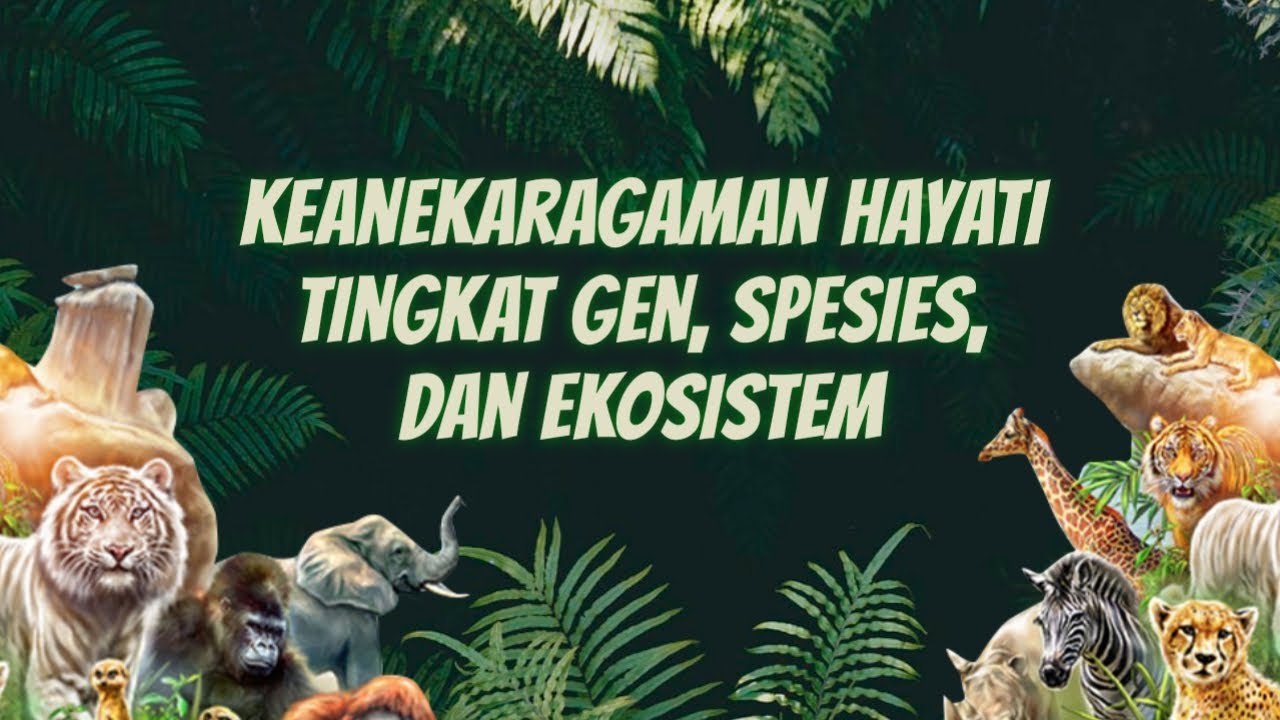Keanekaragaman Hayati | Biologi SMA Kelas 10
Summary
TLDRIn this video, Kak Tia explains the concept of biodiversity in Indonesia, focusing on genetic, species, and ecosystem diversity. She highlights Indonesia's rich variety of flora and fauna, emphasizing its unique position as a hotspot for endemic species like Komodo dragons and Sumatran tigers. The video also explores the geographical boundaries of species distribution, with special attention to the Wallace and Weber lines, which divide Indonesia into distinct ecological zones. Viewers gain an understanding of how these lines impact biodiversity and the classification of plants and animals across the region.
Takeaways
- 😀 Biodiversity refers to the variety of organisms in three levels: genetic diversity, species diversity, and ecosystem diversity.
- 😀 Genetic diversity involves variations within the same species, like different types of mangoes.
- 😀 Species diversity encompasses different species living in one area, such as coconut trees, pinang lontar, and oil palms in a yard.
- 😀 Ecosystem diversity describes various environments like deserts, savannas, forests, and rainforests.
- 😀 Indonesia is home to the highest number of endemic species in the world, such as tarsiers and Sumatran tigers.
- 😀 Indonesia's geographical position influences the distribution of flora and fauna across different regions.
- 😀 The western part of Indonesia (Sumatra, Java, Kalimantan, Bali) has large animal species like elephants and rhinos.
- 😀 The transitional area (Sulawesi, Maluku, Sumbawa, Sumba, Lombok, Timor) is home to animals with transitional traits, like Komodo dragons and anoas.
- 😀 The eastern part of Indonesia (Papua and surrounding islands) is known for small animals with beautiful feathers, like cuscus and Cendrawasih.
- 😀 The Weber and Wallace lines are imaginary lines that define the distribution of plants and animals between the Sahul plains and the western part of Indonesia.
Q & A
What is the concept of biodiversity?
-Biodiversity refers to the variety of organisms living at three levels: genetic diversity, species diversity, and ecosystem diversity.
What is genetic diversity?
-Genetic diversity is the variation in genes within the same species. For example, different varieties of mangoes.
What does species diversity refer to?
-Species diversity refers to the different species living in a particular area. For instance, in a yard, you may find coconut trees, Pinang Lontar, and oil palms, which are different species but have similar characteristics.
What is ecosystem diversity?
-Ecosystem diversity refers to the different environments or habitats where various organisms interact with each other. Examples include deserts, savannas, deciduous forests, and tropical rainforests.
Why is Indonesia considered to have high biodiversity?
-Indonesia is known for its high biodiversity because it has many islands that have been isolated for long periods, leading to the evolution of unique local species such as tarsiers and Sumatran tigers.
What are the three regions that divide the fauna of Indonesia?
-Indonesia's fauna is divided into three regions: the western part, the transitional area, and the eastern part.
What animals are found in the western part of Indonesia?
-The western part of Indonesia, including Sumatra, Java, Kalimantan, and Bali, is home to larger animals like elephants and rhinos.
What is the Wallace line, and what does it represent?
-The Wallace line is an imaginary boundary between the fauna of the western part of Indonesia and the eastern part. It runs from the Makassar Strait to the strait between Bali and Lombok.
What is the Lideker line, and how does it relate to the Wallace line?
-The Lideker line is another boundary that divides the transitional fauna of Indonesia. It lies east of the Wallace line and separates the transitional area from the eastern part of Indonesia.
Who discovered the Weber line and what is its significance?
-The Weber line was discovered by Max Weber, and it marks the distribution of plants and animals between the Sahul plains and the western part of Indonesia.
Outlines

This section is available to paid users only. Please upgrade to access this part.
Upgrade NowMindmap

This section is available to paid users only. Please upgrade to access this part.
Upgrade NowKeywords

This section is available to paid users only. Please upgrade to access this part.
Upgrade NowHighlights

This section is available to paid users only. Please upgrade to access this part.
Upgrade NowTranscripts

This section is available to paid users only. Please upgrade to access this part.
Upgrade NowBrowse More Related Video

Keanekaragaman Hayati | Belajar online mapel biologi

Keanekaragaman Hayati Tingkat Gen, Spesies, dan Ekosistem | Dunia Biologi

UAS PLH KEANEKARAGAMAN HAYATI - ARSYA DWI GUSTAMI - 210210201082

IPA Kelas 10 - Keanekaragaman Hayati | GIA Academy

Video Ep 2 Persiapan SAS Biodiversity Grade 10

Tingkat Keanekaragaman Hayati | Biologi Kelas X
5.0 / 5 (0 votes)